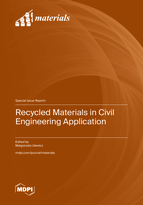Recycled Materials in Civil Engineering Application
A special issue of Materials (ISSN 1996-1944). This special issue belongs to the section "Construction and Building Materials".
Deadline for manuscript submissions: closed (20 September 2023) | Viewed by 29141
Special Issue Editor
Interests: materials engineering; materials chemistry; composites; use of recycled materials and byproduct in concrete; recycled materials for construction; sustainable structures and materials; ecological materials and technologies
Special Issues, Collections and Topics in MDPI journals
Special Issue Information
Dear Colleagues,
The Special Issue “Recycled Materials in Civil Engineering Applications" aims to discuss the preparation and characterization of new ecologically friendly materials containing recycled materials or waste that should find use in specific engineering applications. Using waste and materials from recycling is a key part of decreasing present-day waste. In concrete and other composite materials, recycled materials such as plastics, steel and other metals, ash, glass, ceramics, and industrial wastes see the most use. The application of recycled materials or waste to the production of new materials is consistent with the idea of sustainable construction. Using recycled materials to synthesize composite materials saves the use of natural resources and has a positive influence on environmental protection. Unfortunately, the production of composite materials containing waste, by-products, or recycled materials requires a substantial amount of research, and is a very relevant issue for materials engineers and chemists. For this reason, this Special Issue is an excellent opportunity to present and publish the latest research results in the field of composite material synthesis, particularly cement-based composites and their physicochemical and mechanical properties.
Prof. Malgorzata Ulewicz
Guest Editor
Manuscript Submission Information
Manuscripts should be submitted online at www.mdpi.com by registering and logging in to this website. Once you are registered, click here to go to the submission form. Manuscripts can be submitted until the deadline. All submissions that pass pre-check are peer-reviewed. Accepted papers will be published continuously in the journal (as soon as accepted) and will be listed together on the special issue website. Research articles, review articles as well as short communications are invited. For planned papers, a title and short abstract (about 100 words) can be sent to the Editorial Office for announcement on this website.
Submitted manuscripts should not have been published previously, nor be under consideration for publication elsewhere (except conference proceedings papers). All manuscripts are thoroughly refereed through a single-blind peer-review process. A guide for authors and other relevant information for submission of manuscripts is available on the Instructions for Authors page. Materials is an international peer-reviewed open access semimonthly journal published by MDPI.
Please visit the Instructions for Authors page before submitting a manuscript. The Article Processing Charge (APC) for publication in this open access journal is 2600 CHF (Swiss Francs). Submitted papers should be well formatted and use good English. Authors may use MDPI's English editing service prior to publication or during author revisions.
Keywords
- recycled materials
- waste, by-products, and industrial wastes
- sustainable building materials
- physicochemical and mechanical properties of composites
- synthesis of concrete and other composite







